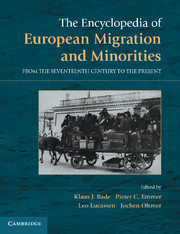Book contents
- Frontmatter
- Contents
- Preface to the English Edition
- Preface to the German Edition
- The Encyclopedia: Idea, Concept, Realization
- Terminologies and Concepts of Migration Research
- Countries
- Northern Europe
- Western Europe
- Central Europe
- Southern Europe
- East-Central Europe
- Southeastern Europe
- Eastern Europe
- Russia and Belarus
- Ukraine
- GROUPS
- APPENDIX
- Index of Migration Types
- Index of Countries, Regions, and Places
GROUPS
from Eastern Europe
Published online by Cambridge University Press: 05 June 2012
- Frontmatter
- Contents
- Preface to the English Edition
- Preface to the German Edition
- The Encyclopedia: Idea, Concept, Realization
- Terminologies and Concepts of Migration Research
- Countries
- Northern Europe
- Western Europe
- Central Europe
- Southern Europe
- East-Central Europe
- Southeastern Europe
- Eastern Europe
- Russia and Belarus
- Ukraine
- GROUPS
- APPENDIX
- Index of Migration Types
- Index of Countries, Regions, and Places
Summary
Administrative Elites in Southern Italy and Sicily under Spanish Rule in the Early Modern Period
Since antiquity, southern Italy and Sicily have been linked to the Mediterranean regions in various ways, and from the Middle Ages also with the political entities north of the Alps. Until the creation of the Italian nation-state in 1861, these regions were ruled by dynasties that were not from Italy. Between 1504 and 1713, they were vice-kingdoms under the suzerainty of Spain. The long period of “foreign rule” had a lasting impact on the political, social, economic, and cultural history of southern Italy.
The Kingdoms of Naples and Sicily played a preeminent role within the Spanish Empire: strategically in the fight against the Turks, economically and militarily as a resource in the defense of Habsburg positions in the contest between the European powers. At the same time, the two kingdoms were part of a dynamic economic, social, and cultural system that was connected to Spain, the Netherlands, Austria, and northern Italy and was based on the continuous exchange of ideas, goods, and people. The importance of this international sphere of communication for southern Italy and Sicily lay not least in the constant immigration of administrative and military personnel, bankers, merchants and seamen, as well as clergymen and artists from all over Europe, but chiefly from Spain.
- Type
- Chapter
- Information
- The Encyclopedia of European Migration and MinoritiesFrom the Seventeenth Century to the Present, pp. 209 - 748Publisher: Cambridge University PressPrint publication year: 2011
- 1
- Cited by

